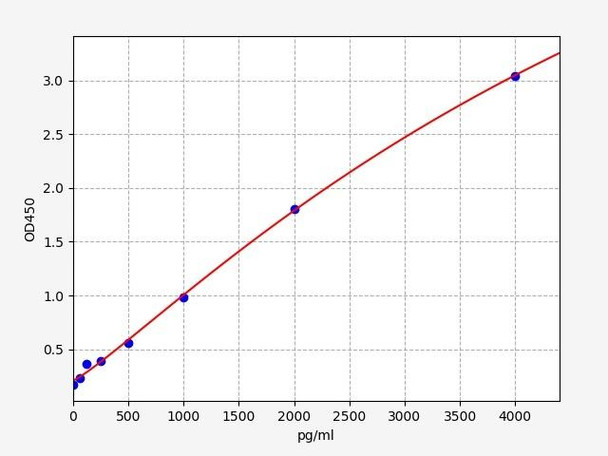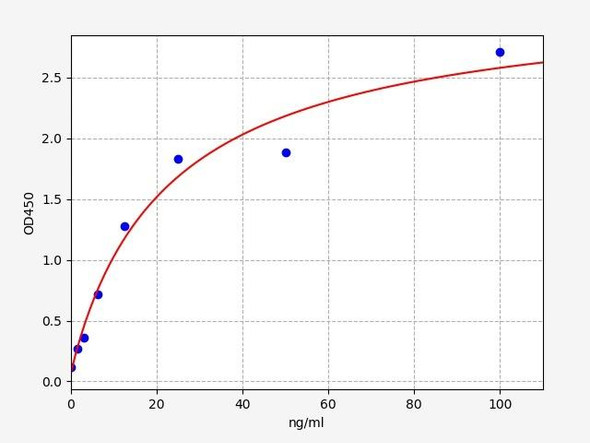Human CD8 alpha/CD8A ELISA Kit (HUFI00839)
- SKU:
- HUFI00839
- Product Type:
- ELISA Kit
- Size:
- 96 Assays
- Uniprot:
- P01732
- Sensitivity:
- 37.5pg/ml
- Range:
- 62.5-4000pg/ml
- ELISA Type:
- Sandwich
- Synonyms:
- CD8A, T-cell surface glycoprotein CD8 alpha chain, T-lymphocyte differentiation antigen T8, Leu-2
- Reactivity:
- Human
- Research Area:
- Immunology
Description
Human CD8 alpha/CD8A ELISA Kit
The Human CD8 Alpha (CD8A) ELISA Kit is a highly sensitive and specific assay designed for the accurate detection of CD8 Alpha levels in human serum, plasma, and cell culture supernatants. This kit provides reliable and reproducible results, making it ideal for a variety of research applications.CD8 Alpha is a critical protein involved in immune response, specifically in the regulation and activation of cytotoxic T cells. It plays a pivotal role in the body's defense against infections and diseases, making it a crucial biomarker for studying immune system function and potential therapeutic interventions.
With its high-quality components and easy-to-follow protocol, the Human CD8 Alpha (CD8A) ELISA Kit is a valuable tool for researchers and clinicians looking to investigate the role of CD8 Alpha in various health conditions and diseases. Get reliable and accurate results with this cutting-edge ELISA kit from Assay Genie.
| Product Name: | Human CD8 alpha/CD8A ELISA Kit |
| Product Code: | HUFI00839 |
| Size: | 96 Assays |
| Alias: | CD8A, T-cell surface glycoprotein CD8 alpha chain, T-lymphocyte differentiation antigen T8, Leu-2 |
| Detection method: | Sandwich ELISA, Double Antibody |
| Application: | This immunoassay kit allows for the in vitro quantitative determination of Human CD8A concentrations in serum plasma and other biological fluids. |
| Sensitivity: | 37.5pg/ml |
| Range: | 62.5-4000pg/ml |
| Storage: | 4°C for 6 months |
| Note: | For Research Use Only |
| Recovery: | Matrices listed below were spiked with certain level of Human CD8A and the recovery rates were calculated by comparing the measured value to the expected amount of Human CD8A in samples. | ||||||||||||||||
| |||||||||||||||||
| Linearity: | The linearity of the kit was assayed by testing samples spiked with appropriate concentration of Human CD8A and their serial dilutions. The results were demonstrated by the percentage of calculated concentration to the expected. | ||||||||||||||||
| |||||||||||||||||
| CV(%): | Intra-Assay: CV<8% Inter-Assay: CV<10% |
| Component | Quantity | Storage |
| ELISA Microplate (Dismountable) | 8×12 strips | 4°C for 6 months |
| Lyophilized Standard | 2 | 4°C/-20°C |
| Sample/Standard Dilution Buffer | 20ml | 4°C |
| Biotin-labeled Antibody(Concentrated) | 120ul | 4°C (Protect from light) |
| Antibody Dilution Buffer | 10ml | 4°C |
| HRP-Streptavidin Conjugate(SABC) | 120ul | 4°C (Protect from light) |
| SABC Dilution Buffer | 10ml | 4°C |
| TMB Substrate | 10ml | 4°C (Protect from light) |
| Stop Solution | 10ml | 4°C |
| Wash Buffer(25X) | 30ml | 4°C |
| Plate Sealer | 5 | - |
Other materials and equipment required:
- Microplate reader with 450 nm wavelength filter
- Multichannel Pipette, Pipette, microcentrifuge tubes and disposable pipette tips
- Incubator
- Deionized or distilled water
- Absorbent paper
- Buffer resevoir
| Uniprot | P01732 |
| UniProt Protein Function: | Function: Identifies cytotoxic/suppressor T-cells that interact with MHC class I bearing targets. CD8 is thought to play a role in the process of T-cell mediated killing. CD8 alpha chains binds to class I MHC molecules alpha-3 domains. |
| UniProt Protein Details: | Subunit structure: In general heterodimer of an alpha and a beta chain linked by two disulfide bonds. Can also form homodimers. Shown to be expressed as heterodimer on thymocytes and as homodimer on peripheral blood T-lymphocytes. Interacts with the MHC class I HLA-A/B2M dimer. Interacts with LCK in a zinc-dependent manner. Ref.9 Subcellular location: Isoform 1: Cell membrane; Single-pass type I membrane protein. Isoform 2: Secreted. Post-translational modification: All of the five most C-terminal cysteines form inter-chain disulfide bonds in dimers and higher multimers, while the four N-terminal cysteines do not By similarity. Involvement inDisease: CD8 deficiency, familial (CD8 deficiency) [MIM:608957]: An immunologic defect characterized by absence of CD8+ cells, leading to recurrent bacterial infections.Note: The disease is caused by mutations affecting the gene represented in this entry. Sequence similarities: Contains 1 Ig-like V-type (immunoglobulin-like) domain. |
| NCBI Summary: | The CD8 antigen is a cell surface glycoprotein found on most cytotoxic T lymphocytes that mediates efficient cell-cell interactions within the immune system. The CD8 antigen acts as a coreceptor with the T-cell receptor on the T lymphocyte to recognize antigens displayed by an antigen presenting cell in the context of class I MHC molecules. The coreceptor functions as either a homodimer composed of two alpha chains or as a heterodimer composed of one alpha and one beta chain. Both alpha and beta chains share significant homology to immunoglobulin variable light chains. This gene encodes the CD8 alpha chain. Multiple transcript variants encoding different isoforms have been found for this gene. [provided by RefSeq, Nov 2011] |
| UniProt Code: | P01732 |
| NCBI GenInfo Identifier: | 116035 |
| NCBI Gene ID: | 925 |
| NCBI Accession: | P01732.1 |
| UniProt Secondary Accession: | P01732,Q13970, Q4ZG17, D6W5M8, |
| UniProt Related Accession: | P01732 |
| Molecular Weight: | |
| NCBI Full Name: | T-cell surface glycoprotein CD8 alpha chain |
| NCBI Synonym Full Names: | CD8a molecule |
| NCBI Official Symbol: | CD8A |
| NCBI Official Synonym Symbols: | CD8; MAL; p32; Leu2 |
| NCBI Protein Information: | T-cell surface glycoprotein CD8 alpha chain; T8 T-cell antigen; T cell co-receptor; OKT8 T-cell antigen; T-cell antigen Leu2; Leu2 T-lymphocyte antigen; CD8 antigen, alpha polypeptide (p32); T-lymphocyte differentiation antigen T8/Leu-2 |
| UniProt Protein Name: | T-cell surface glycoprotein CD8 alpha chain |
| UniProt Synonym Protein Names: | T-lymphocyte differentiation antigen T8/Leu-2 |
| Protein Family: | CD81 antigen |
| UniProt Gene Name: | CD8A |
| UniProt Entry Name: | CD8A_HUMAN |
*Note: Protocols are specific to each batch/lot. For the correct instructions please follow the protocol included in your kit.
Before adding to wells, equilibrate the SABC working solution and TMB substrate for at least 30 min at 37°C. When diluting samples and reagents, they must be mixed completely and evenly. It is recommended to plot a standard curve for each test.
| Step | Protocol |
| 1. | Set standard, test sample and control (zero) wells on the pre-coated plate respectively, and then, record their positions. It is recommended to measure each standard and sample in duplicate. Wash plate 2 times before adding standard, sample and control (zero) wells! |
| 2. | Aliquot 0.1ml standard solutions into the standard wells. |
| 3. | Add 0.1 ml of Sample / Standard dilution buffer into the control (zero) well. |
| 4. | Add 0.1 ml of properly diluted sample ( Human serum, plasma, tissue homogenates and other biological fluids.) into test sample wells. |
| 5. | Seal the plate with a cover and incubate at 37 °C for 90 min. |
| 6. | Remove the cover and discard the plate content, clap the plate on the absorbent filter papers or other absorbent material. Do NOT let the wells completely dry at any time. Wash plate X2. |
| 7. | Add 0.1 ml of Biotin- detection antibody working solution into the above wells (standard, test sample & zero wells). Add the solution at the bottom of each well without touching the side wall. |
| 8. | Seal the plate with a cover and incubate at 37°C for 60 min. |
| 9. | Remove the cover, and wash plate 3 times with Wash buffer. Let wash buffer rest in wells for 1 min between each wash. |
| 10. | Add 0.1 ml of SABC working solution into each well, cover the plate and incubate at 37°C for 30 min. |
| 11. | Remove the cover and wash plate 5 times with Wash buffer, and each time let the wash buffer stay in the wells for 1-2 min. |
| 12. | Add 90 µl of TMB substrate into each well, cover the plate and incubate at 37°C in dark within 10-20 min. (Note: This incubation time is for reference use only, the optimal time should be determined by end user.) And the shades of blue can be seen in the first 3-4 wells (with most concentrated standard solutions), the other wells show no obvious color. |
| 13. | Add 50 µl of Stop solution into each well and mix thoroughly. The color changes into yellow immediately. |
| 14. | Read the O.D. absorbance at 450 nm in a microplate reader immediately after adding the stop solution. |
When carrying out an ELISA assay it is important to prepare your samples in order to achieve the best possible results. Below we have a list of procedures for the preparation of samples for different sample types.
| Sample Type | Protocol |
| Serum | If using serum separator tubes, allow samples to clot for 30 minutes at room temperature. Centrifuge for 10 minutes at 1,000x g. Collect the serum fraction and assay promptly or aliquot and store the samples at -80°C. Avoid multiple freeze-thaw cycles. If serum separator tubes are not being used, allow samples to clot overnight at 2-8°C. Centrifuge for 10 minutes at 1,000x g. Remove serum and assay promptly or aliquot and store the samples at -80°C. Avoid multiple freeze-thaw cycles. |
| Plasma | Collect plasma using EDTA or heparin as an anticoagulant. Centrifuge samples at 4°C for 15 mins at 1000 × g within 30 mins of collection. Collect the plasma fraction and assay promptly or aliquot and store the samples at -80°C. Avoid multiple freeze-thaw cycles. Note: Over haemolysed samples are not suitable for use with this kit. |
| Urine & Cerebrospinal Fluid | Collect the urine (mid-stream) in a sterile container, centrifuge for 20 mins at 2000-3000 rpm. Remove supernatant and assay immediately. If any precipitation is detected, repeat the centrifugation step. A similar protocol can be used for cerebrospinal fluid. |
| Cell culture supernatant | Collect the cell culture media by pipette, followed by centrifugation at 4°C for 20 mins at 1500 rpm. Collect the clear supernatant and assay immediately. |
| Cell lysates | Solubilize cells in lysis buffer and allow to sit on ice for 30 minutes. Centrifuge tubes at 14,000 x g for 5 minutes to remove insoluble material. Aliquot the supernatant into a new tube and discard the remaining whole cell extract. Quantify total protein concentration using a total protein assay. Assay immediately or aliquot and store at ≤ -20 °C. |
| Tissue homogenates | The preparation of tissue homogenates will vary depending upon tissue type. Rinse tissue with 1X PBS to remove excess blood & homogenize in 20ml of 1X PBS (including protease inhibitors) and store overnight at ≤ -20°C. Two freeze-thaw cycles are required to break the cell membranes. To further disrupt the cell membranes you can sonicate the samples. Centrifuge homogenates for 5 mins at 5000xg. Remove the supernatant and assay immediately or aliquot and store at -20°C or -80°C. |
| Tissue lysates | Rinse tissue with PBS, cut into 1-2 mm pieces, and homogenize with a tissue homogenizer in PBS. Add an equal volume of RIPA buffer containing protease inhibitors and lyse tissues at room temperature for 30 minutes with gentle agitation. Centrifuge to remove debris. Quantify total protein concentration using a total protein assay. Assay immediately or aliquot and store at ≤ -20 °C. |
| Breast Milk | Collect milk samples and centrifuge at 10,000 x g for 60 min at 4°C. Aliquot the supernatant and assay. For long term use, store samples at -80°C. Minimize freeze/thaw cycles. |






